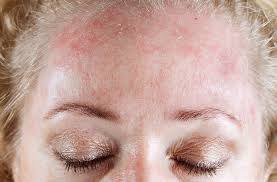
Seborrheic Dermatitis: Causes, Symptoms, and Treatment
Peeling or flaking skin on your face or scalp can be a sign of a condition called seborrheic dermatitis (seb derm), a type of facial redness that is sometimes referred to as “facial dandruff.” This condition commonly causes redness, irritation, and greasy scales around areas like the nose, forehead, eyebrows, and scalp. Many people think it is eczema, but eczema has different causes.
If you are struggling with these redness and flaking in your central face, use this blog as a guide to help you better understand what seborrheic dermatitis is, what causes it, and how to treat it.
Seborrheic dermatitis causes itchy, flaky, and scaly patches in the central face and scalp
Caused by overactive immune response
May be caused by a specific type of yeast on the skin.
Antifungal medications, anti-inflammatory creams, and medicated shampoos and cleansers help to manage symptoms.
What Is Seborrheic Dermatitis?
While the prefix “sebo” means sebum (oil), seborrheic dermatitis actually has nothing to do with sebum or sebaceous glands. This name is a misnomer, as scientists originally thought seborrheic dermatitis was a disease of the sebaceous, or oil glands, but we now know that it is not. The latest research suggests that seb derm is more related to immune system responses, stress, and other factors.
Seborrheic dermatitis primarily appears as greasy, red, scaly patches around areas where there is hair, such as the forehead, eyebrows, and scalp. It is also commonly seen on the nose and behind the ears and can cause skin flaking that resembles dandruff. Unlike regular dry skin, seb derm produces scales that are often greasy in texture, giving the affected areas a shiny appearance. It can flare up at any time, especially during stress or changes in the weather, and tends to recur if left untreated.
Seb Derm and Oily Skin
Seborrheic dermatitis is not associated with increased sebum production (known as seborrhea). (6) You can have oily skin and seb derm, but the oiliness is not causing the seb derm. They are unrelated in spite of the name.
Seb Derm and Dry Skin
The peeling red scaling patches on the face characteristic of seborrheic dermatitis appear to be dry- so many people think seb derm is caused by dry skin. However, dehydration does not cause seb derm- inflammation does. Skin that is inflamed from seb derm does have a damaged barrier, but this damage is due to inflammation that affects the stratum corneum’s ability to hold onto water.
You can have dry skin and seborrheic dermatitis, but treating the dryness alone will not cure the problem. You need to treat the inflammation and its causes.
What Causes Seborrheic Dermatitis?
The exact cause of seborrheic dermatitis is not fully understood, but there are a few factors that are known to trigger or worsen its symptoms:
Overgrowth of Malassezia yeast. A type of naturally occurring yeast called Malassezia lives on everyone’s skin, but in people with seborrheic dermatitis, it can grow out of control. This overgrowth is thought to irritate the skin and trigger the immune response that leads to the characteristic redness, flaking, and inflammation of seborrheic dermatitis.
Immune system response. Some research suggests that people with seborrheic dermatitis may have an abnormal immune reaction to the Malassezia yeast, leading to chronic inflammation (3).
Stress. Stress is a known trigger for many skin conditions related to inflammation, including seborrheic dermatitis. Periods of high stress can lead to symptom flare-ups.
Hormonal fluctuations. Hormones may also play a role in the development or worsening of seborrheic dermatitis, particularly during puberty, pregnancy, menopause, or other times of hormonal imbalance.
Symptoms of Seb Derm
Seborrheic dermatitis has several key symptoms, which can vary in intensity from person to person:
Flaky skin. One of the most common symptoms is flaky skin that often appears in the central face, the T-zone (forehead, nose, and chin), eyebrows, scalp, and around the ears. These flakes are often greasy and yellowish in color or may be white, dry flakes associated with dandruff.
Greasy scaling. The patches of flaky skin are usually greasy, shiny, or light grey or white in appearance
Redness and irritation. Affected areas are often red and inflamed.
Itching. Seborrheic dermatitis can be itchy. The itching often becomes worse when the skin is irritated or dry.
How Is Seborrheic Dermatitis Treated?
While seborrheic dermatitis can be cured with the right treatment plan, but it has a tendency to come back.
The key is to reduce inflammation, control yeast overgrowth, and soothe irritated skin. These are some of the most common treatment options for this condition:
Anti-yeast treatments. Since seborrheic dermatitis is often linked to an overgrowth of yeast, antifungal treatments can help to reduce inflammation and other symptoms. Products containing ketoconazole, selenium sulfide, or zinc pyrithione are commonly used to reduce the yeast on the skin.
Topical steroids. In more severe cases, a mild topical steroid may be used to reduce inflammation and itching. These should be used for short periods to avoid potential side effects, such as skin thinning.
Anti-inflammatory creams. Non-steroidal anti-inflammatory creams may be recommended for long-term control of redness and itching without the side effects of steroids.
Soothing oils- oil like Argan oil with soothing fatty acids are a natural way to treat dandruff on the face.
Medicated shampoos and cleansers. Medicated shampoos and face washes that contain ketoconazole, salicylic acid, or sulfur can help to reduce symptoms on the scalp and face.
Moisturizers. Keeping your skin moisturized is crucial for managing seborrheic dermatitis. Choose moisturizer with soothing anti-inflammatory ingredients. Match your moisturizer to your skin type- you need different types if you have underlying dry or oily skin.
Best Products for Seborrheic Dermatitis
The best products for seborrheic dermatitis are formulated with gentle yet effective ingredients that target yeast overgrowth, reduce inflammation, and keep your skin moisturized. Some of the top products that I recommend to my patients dealing with seborrheic dermatitis include shampoos, facial cleanser, anti-inflammatory serums, and soothing moisturizers. Which to choose depends on which of the 16 skin types you are.
Shampoos and Face Wash
Soothing Serums and Creams
Bottom Line
Itching, redness, and flaking caused by seborrheic dermatitis can be frustrating to deal with. However, with the right treatment regimen designed for your skin type, you can effectively manage these symptoms and enjoy calm, comfortable skin.
If you don’t know your skin type yet, be sure to take the quiz to find out so you and your dermatologist can customize your skin care regimen based on your skin’s unique needs.


